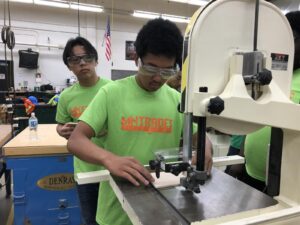Construction Apprenticeships: Minnesota’s Need for more Construction workers
Are you interested in pursuing a career in Minnesota’s construction trades? Do you envision yourself as an electrician, a pipefitter, an ironworker or a heavy-equipment operator?
If you do, you should consider applying for a registered apprenticeship with one of Minnesota building and construction trades.

Programs such as the Minnesota Trades Academy(MTA) give students hands-on construction skills training in high school. Students get paid throughout their summer internship with MTA. PC:Emily Sweeney
In a construction apprenticeship program, apprentices learn skills and knowledge from other experienced professionals known as journeypersons. Apprentices can specialize in certain crafts or skills that are taught during the duration of their training such as carpentry, masonry, plumbing or welding. In fact, according to ConstructionCareers.org, there are more than 30 possible career pathways in Minnesota’s construction trades.
Being accepted as an apprentice is dependent upon the apprenticeship program offered by each construction trade (typically through a construction trade union). General requirements include being at least 18 years of age, a high school diploma or GED equivalent, and a driver’s license (with reliable transportation to get to job sites). Some apprentices start right after high school, while others transition into apprenticeships after attending a technical college or working for a non-union construction company.
“We work with community partners, educators and parents to ensure that high school students get exposure to careers in construction that they may not be familiar with,” said Sarah Lechowich, Senior Director for the Construction Careers Foundation. “In building these relationships with youth and having discussions on the benefits of apprenticeship we are also connecting union training facilities and business leaders with the future of Minnesota’s labor workforce.”
Like attending a four-year college, apprenticeship serves as a career preparation route. However, there are three key components that make a registered apprenticeship unique from other forms of postsecondary education.
Registered versus Non-registered Apprenticeships
There are two types of apprenticeship programs: Registered apprenticeship programs (RAPs), or non-registered programs, also known as industry-recognized apprenticeship programs (IRAPs).
“Minnesota has more than 11,000 registered apprentices, over 10,000 are in union construction apprenticeship programs,” according to Jennifer Hathaway, communications manager for the Minnesota Building and Construction Trades Council. “The union construction industry has 54 privately funded registered apprenticeship programs around the state, serving as the primary training pipeline for people entering the construction industry.”
RAPs have been validated either federally by the U.S. Department of Labor or locally by the Minnesota Department of Employment and Economic Development (DEED), and meet specific standards set by those agencies. IRAPs are not registered with a government agency and are not tied to the government requirements.
“There are advantages to being a registered union apprentice such as access to government resources and industry-recognized quality training, credentials and career opportunities,” Lechowich said. “In addition, completing a registered apprenticeship program in Minnesota is recognized by construction trade unions in other states, which means you don’t need to go through another apprenticeship if you decide to move to another state.”
Learning on the Job and In the Classroom
The training an apprentice receives is split between classroom education and on-the-job training (OJT). Typically, apprentices spend 80% of their program in the field and the remaining 20% in the classroom.
In general, apprenticeship programs can last up to four years and during this time apprentices also earn additional industry recognized credentials and certifications to represent their skills and knowledge progression. For some professions, passing a state-administered exam is required at the end of the apprenticeship to obtain a license to work in a trade.
Apprentices commonly complete their OJT work during the day with the classroom instruction being held at night. In some regions with cold winters where construction work is limited by weather, the indoors learning might be more heavily scheduled during the snow season.
With this hybrid system, trainees have a valuable and relevant educational experience where they learn theories and concepts and are immediately able to apply and practice them in a hands-on way.
Earn While You Learn
Apprentices receive wages for their on-the-job work, which increase incrementally as they progress through their apprenticeship training. In other words, they get paid to learn the skills they will use in their careers.
Due to the high demand for craft professionals and construction skills, many companies invest in their apprentices and take on any additional costs associated with the education and will often directly hire apprentices to full-time positions upon completion of the program.
